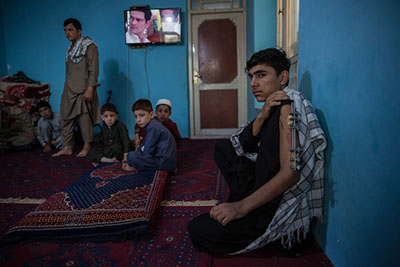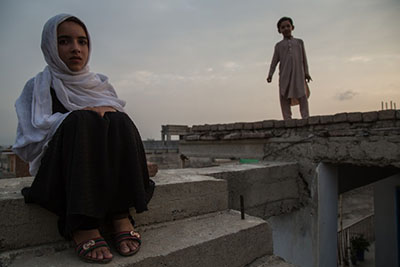By Stefanie Glinski
KABUL, Afghanistan — The dull, throbbing sound of the helicopter breaks the silence of the clear starry night.
As it approaches, the swishing of each blade clearly distinguishable, Hajatullah Gul, 30, and his family lie under mosquito nets in their beds outside, their bodies drenched in cold, nervous sweat.
“Sometimes they strike in the village,” Gul’s 6-year-old son Assad whispers, referring to Afghanistan’s National Army. “I’m afraid of them.”

Badshah Dullah, 40, stands in what is left of his house that was hit by a U.S. airstrike 15 years ago. The family can't afford to repair it. (Photo: Stefanie Glinski/The Times)
Relief sets in almost instantly as the engine passes over the family’s eastern Afghanistan compound and disappears in the distance. What’s left is adrenaline and the barking of dogs. Heart still racing, Gul pulls his sheets in closer, turns over and goes back to sleep.
Gul and his family — at least 20 people including his brothers and their wives and children — live, like thousands of others across Afghanistan, in harm’s way.
His village, a cluster of brown mud compounds built alongside dusty barren hills outside Khost city, is host to many Taliban-affiliated families. The family claims no allegiance to the Taliban or any other militant group, although several members in the past have worked alongside U.S. forces or with the Afghan National Army.
“It’s the crossfire we don’t want to get caught in,” said Gul.
Nearly two decades of warfare since the U.S.-led invasion have left people on all sides of Afghanistan’s conflict afflicted with fear.
And even as peace talks continue between the U.S. and the Taliban, the fighting has taken a turn for the worse.
Last year was the deadliest yet for civilians since U.N. records have been kept in the past decade, with almost 4,000 civilians killed and over 7,000 injured.
More than 60% of the deaths and injuries last year were attributed to antigovernment elements, mainly the Taliban and an Islamic State affiliate; nearly 25% were caused by pro-government forces, according to the U.N. figures.
The toll this year has been equally grim. Through June, almost 4,000 civilians had been killed or injured, with increased U.S. airstrikes playing a role in a surge of deaths attributable to pro-government forces. This year, such deaths have been more than double those caused by antigovernment forces, according to the U.N. statistics.

Naveed Nazari, 19, was shot in the left arm when the Taliban attacked his checkpoint on the outskirts of Kunduz city. (Photo: Stefanie Glinski/The Times)
Further leading to fear have been statements by President Trump that he could wipe Afghanistan off the face of the earth and bring the war to an end in 10 days — even as the peace talks continue in Doha, Qatar.
It’s the Taliban that Naveed Nazari, a 19-year-old Afghan police officer, is afraid of. Two months ago, his checkpoint on the outskirts of Kunduz city in northern Afghanistan was attacked, leaving three of his colleagues dead. With a bullet through his left arm, he was relatively lucky, but he said both trauma and depression continue to hold him captive.
“I barely leave the house these days and I dread the day I have to go back to work,” he said. “At night, it’s always the same dream: the shooting, the attack, the deaths.”
Back in Archi district, where his family lives, most of his friends have joined the Taliban.
“I could have done the same, but I wanted to stay on the government’s side,” he explained. “Either way, this war is a dangerous, scary business, but I hope I can move on fearlessly again in the future.”
Fear has had Qary Khalid, a Taliban commander, pack up the white flags the group often puts out in its territory. He was afraid that surveillance drones might see them and an airstrike could ensue.
Speaking from his house in rural Nangarhar province in the east of the country, Khalid, covering his face with a bandanna, said he lives in the midst of the fighting. “We’re afraid of U.S. surveillance. If they find anything, they might attack.”
Khalid said his main concern is his two toddlers.“Last year, our house was raided by the Afghan army during a meeting of village elders. Seven people were killed. I don’t want my children to get caught in the crossfire.”
Fears aside, the 25-year-old believes in the Taliban’s cause and is eager to oust foreign troops. This, to Khalid, includes the foreign fighters who swear allegiance to Islamic State.
Bilal Ahmat, a 28-year-old Pakistani, is one of them. He arrived in Afghanistan eight years ago to join the Taliban, but moved over to Islamic State two years ago, having decided that the Taliban has lost its vision.

Hadia Mustaghn, 8, witnessed a house raid that left three of her uncles dead. The family has since moved to Khost city, the provincial capital, but Hadia says she's constantly afraid. (Photo: Stefanie Glinski/The Times)
Having deleted all content from his cellphone, he travels to the provincial capital of Jalalabad on back roads, avoiding police checkpoints. He sat nervously on a cushion at a riverside restaurant, scanning the sky.
The five things he’s most afraid of? “The Americans, the Taliban, the government, surveillance drones and airstrikes.
“I’m not afraid of death,” he said, belying his jittery demeanor.
Ahmat, who spends most of his time in Achin district, an Islamic State stronghold in Nangarhar, said he’s ready to sacrifice his life for jihad.
It’s the sound of helicopters and drones that kept 8-year-old Hadia Mustaghn awake at night in rural Khost province before her family resettled in the city.
“I woke up to the sound of an explosion and soldiers running into our house,” the young girl explained, a white scarf wrapped around her head, as she sat on a metal bed on the rooftop of her family’s home. “In the morning, we found three of my uncles killed. The soldiers had been using a gun that doesn’t make a sound, that’s why we didn’t know earlier.”
Hadia said that, since the raid seven months ago, she hasn’t been sleeping well. It was a CIA-trained unit of Afghan soldiers that targeted her family. “I get scared when it gets dark,” she said. “I still cry a lot and I have nightmares.”
Badshah Dullah, 40, who lives in Gurboz Sarah village in Khost province, said it was his father’s fear that led to the destruction of the family’s home.
“Fifteen years ago, he was keeping watch at night, trying to defend and protect us. He got nervous when American foot soldiers passed by, so he shot at them.
“They called for an airstrike, and the house was destroyed that same night,” Dullah remembers.
His father has since passed away. Standing in the rubble — the family has been unable to afford the repairs — he says little has changed over 15 years.
“No matter what side of the war you’re on,” he said, “we all have one thing in common: fear. And it sits deep.”
Glinski is a special correspondent.



